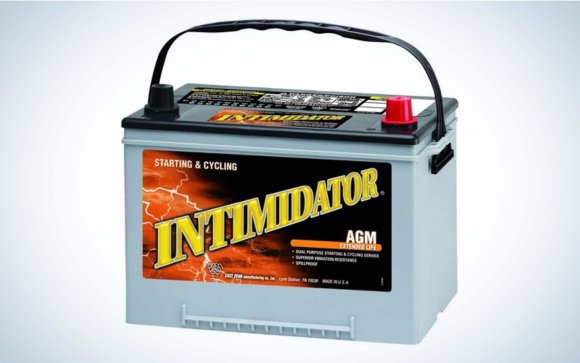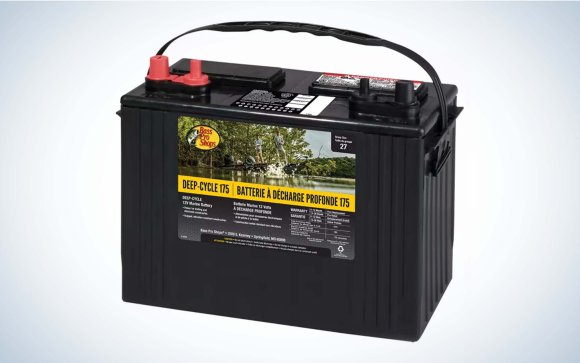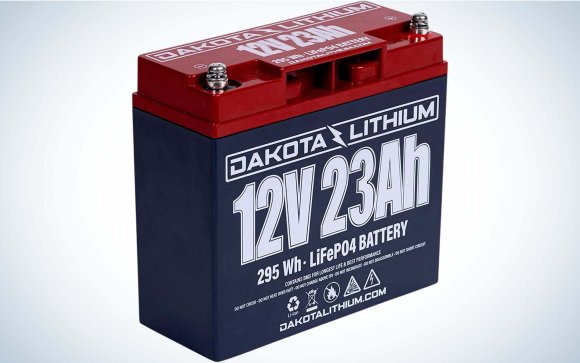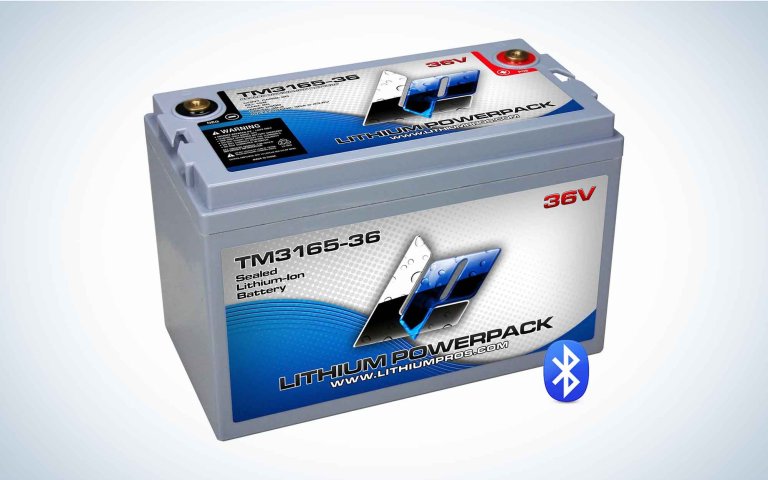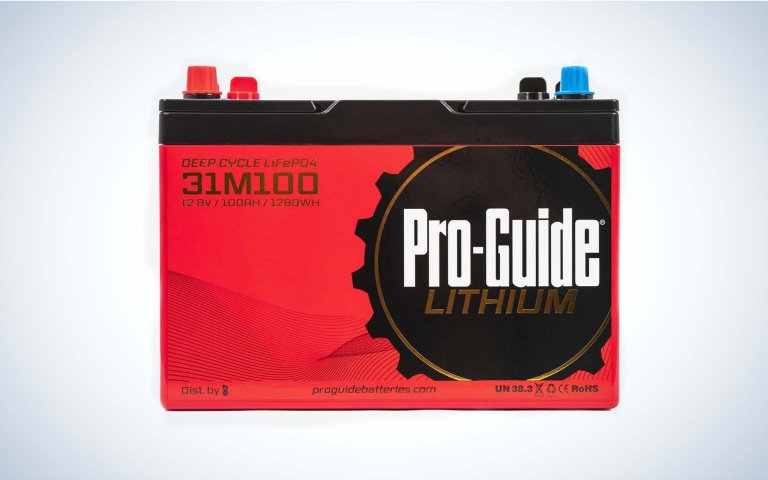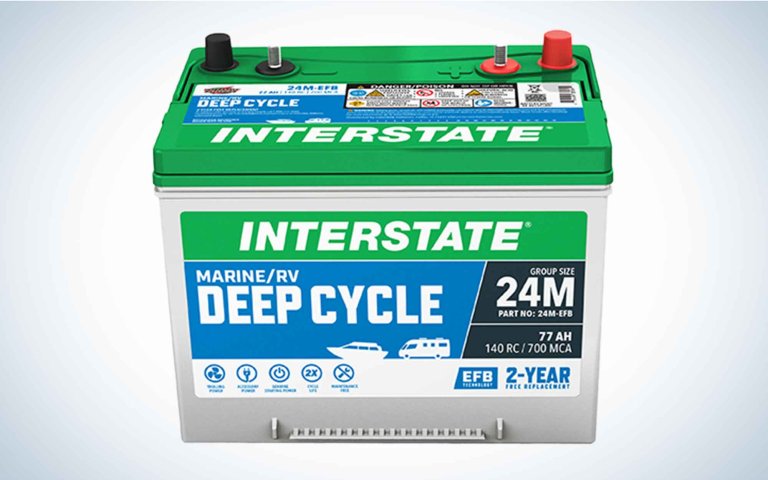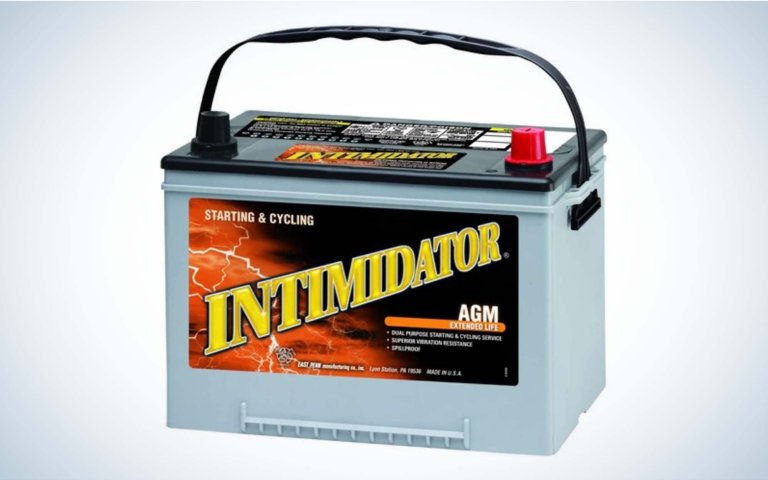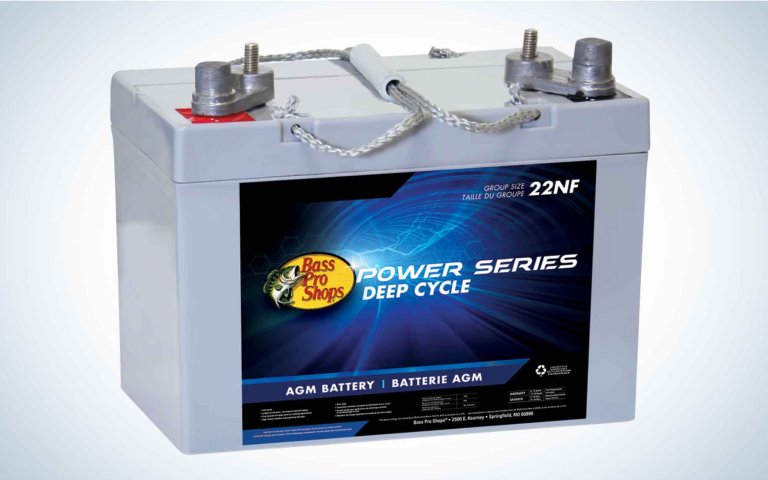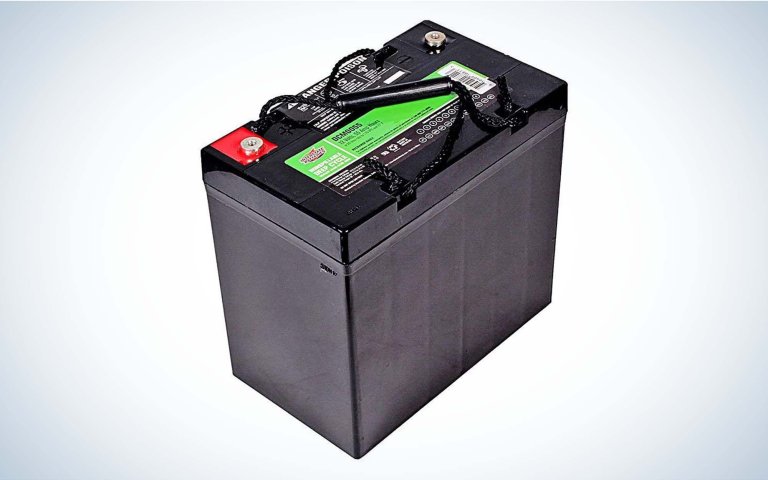We may earn revenue from the products available on this page and participate in affiliate programs. Learn More ›
Across the board, the best trolling motor batteries are likely to last at least all day on a charge, and not leave you stranded or weakened after hundreds of charge cycles. Beyond that, there are a myriad of considerations to take into account when buying your power source, including the size of your boat, your budget, how many you’ll need, and weight considerations.
When I bought my first bass boat in 1996, the choices were relatively simple: You bought what the marine dealer had, or whatever you could find at the local big box or automotive store. You also expected random failures, and at the least, to have to replace your batteries every few years. Some anglers I know even carried an extra in their tow vehicles for the semi-regular failures. At the time, we didn’t know better, but those limited choices underserved us.
My 18-foot bass boat had a 12/24 volt trolling motor and 43 pounds of thrust. Today my 20-foot model has a 36-volt trolling motor and 112 pounds of thrust. Where I once had to fire up the outboard to go from one isolated piece of cover to the next, now I can just run the electric. Just as importantly, perhaps, I expect to be able to do that at the end of a long day of fishing just as quickly as I do at the very start. Today’s batteries are stronger, more bulletproof, and in some cases, costlier, so make sure that you buy the correct option or options for your boating choice.
After more than 20 years of testing the best trolling motor batteries here are my favorites:
- Best All-in-One: Lithium Pro TM3165-36
- Best Lithium: Pro-Guide Lithium
- Best Budget: Interstate Deep Cycle Batteries
- Best AGM: Deka Intimidator AGM Batteries
- Best Budget AGM: Bass Pro Shops Power Series Deep-Cycle AGM Marine Battery
- Best Compact: Optima Bluetop Batteries
- Best for Kayaks: Dakota Lithium 12V 23AH Deep Cycle Battery
- Best Budget for Kayaks: Interstate 12V DCM0035
How I Chose the Best Trolling Motor Batteries
I am hard on trolling motor batteries I spend lots of time with the trolling motor on high, and long days of deep discharges that take max effort from my charger. I’m also a value-hound, with a strong preference for saving dollars, but willing to spend more when it makes financial and practical sense to do so. Over nearly 30 years of boat ownership I’ve tried just about every strategy and realized that there are pros and cons to all of them.
Best Trolling Motor Batteries: Reviews & Recommendations
Best All-in-One: Lithium Pro TM3165-36
Pros
- Lightweight
- Bluetooth connectivity
- Easy-to-use QuickView map
Cons
- Not inexpensive
Key Features
- Group 31 size
- Replaces three 12V batteries
- 42.9 pounds
If your bilge compartment is crowded, or the rear end of your boat suffers during holeshot, you won’t know what to do with the extra space or the extra oomph during takeoff after replacing your batteries with the Lithium Pros. You’ll remove hundreds of pounds of weight while also getting more power and longevity. This three-in-one solution can be charged over 3,000 times without losing effectiveness and they’re super-advanced. After downloading the QuickView App, you’ll be able to instantly know exactly how much power is left. They’re costly, but if you value space and effectiveness, it may be a worthwhile tradeoff.
Best Lithium: Pro-Guide Lithium
Pros
- Enclosed cell dampens the impact of vibrations
- Light weight makes them manageable
- Withstands environmental stressors well
Cons
- Not inexpensive, especially if you need more than one
Key Features
- Three sizes (largest/heaviest is 26 pounds)
- Unique corrosion-resistant terminals
- State of charge indicator built into the case
- Rates for 2500 cycles
Lithium batteries are the darlings of the boating world and also the villains. When working properly, they deliver max power for long periods of time in a package that weighs about a third of their AGM counterparts. On the flip side, they’re quite expensive, and some have suffered through random shutdowns. Also, some lithium batteries have been blamed for fires. So when I decided to invest in three Pro-Guide Lithiums for my new boat, I was wary but the weight and performance benefits won out.
So far, I’ve been thrilled. Embarrassingly, I didn’t have my charger set up properly at first. I actually made it through six long days on the water before I even noticed. That would never happen with any other battery type. Moreover, they charge quickly, and it’s easy to see the state of charge. The power is insane—I can cut through grass and haul long distances between docks in a flash. At only 26 pounds apiece, it adds speed and maneuverability to my boat, and with a capacity of 100 amp hours, I’ve yet to run them down, despite trying my best.
Best Budget: Interstate Deep Cycle Batteries
Pros
- Very affordable
- Widely available
- Proven technology
Cons
- Not as powerful as some more updated batteries
Key Features
- Numerous configurations in 24, 27, and 31 footprints
- Proven wet cell construction
- 24 month free replacement
The green top Interstates are available at marine dealers, tackle stores, and automotive shops everywhere and they’ve stood the test of time, powering everything from one-man molded boats to Bassmaster Classic winners for decades. They feature simple and proven technology. Without any bells or whistles there’s little to go wrong. Find the one that fits your needs, keep it hydrated, and it’ll keep you going for years on a budget.
Best AGM: Deka Intimidator AGM Batteries
Pros
- Maintained power for many years
- High level of vibration resistance
- High level of freeze resistance
Cons
- Heavy weight may make installing and removing difficult
Key Features
- 11 different models available (some better suited for trolling motors than others)
- Protection against deep discharging
- No-spill design prevents acid leaks
AGM batteries are the battleships of the trolling motor world. They’re more vibration-resistant, more powerful, and more maintenance-free than wet cells, but also more expensive, much more unwieldy, and heavy.
These are a really good choice if you’re ready to make the leap. I had some in my last bass boat, and when an unrelated engine problem stranded me six miles from the ramp, I made it back in relatively good time just on the electric—four years after the initial battery purchase. They were still going as strong that day as the day I bought the boat. To me, that’s the greatest endorsement ever. The 31M models that I’ve used have 1000 marine cranking amps and 200 minutes of reserve capacity, which means they’ll start your boat as well as they run the trolling motor, if you prefer to use them for alternate purposes. They’re readily available at a variety of retailers and outlets, and even if you’re using “another brand,” you may actually be using Dekas just badged as something else.
Best Budget AGM: Bass Pro Shops Power Series Deep-Cycle AGM Marine Battery
Pros
- Can be used for both cranking and deep cycle purposes
- Vibration and impact resistant
- Set it and forget it
Cons
- Fairly heavy
Key Features
- Sizes 22, 24, and 31
- Dual purpose starting and deep cycle
- Maintenance free
If you want a little bit more power and performance than a lead acid battery, and you’re willing to pay for it, but not for lithiums, then an AGM is your best bet. These are widely available and effectively require no maintenance. They’re heavy, but you’re getting value in all of those pounds. You also get the proven imprimatur of Bass Pro Shops behind them – that includes a really good warranty if something should go wrong, although you almost certainly won’t. They have lots of power and you can mix and match them for both starting and deep cycle purposes. Hook multiple tools up and prepare to fish hard, because there’s a lot of bang for your buck in these compact but heavy packages.
Best Compact: Optima Bluetop Batteries
Pros
- Survives hundreds of recharges
- Can be mounted in virtually any position
- Dual-use
Cons
- Pricey
Key Features
- Four sizes
- Maintenance free
- Compact design
The Optima Bluetops incorporate AGM design into a frame that’s lighter and substantially more compact than the often-unwieldy AGMs from other manufacturers. That means you get the incredible runtime and the high number of recharges this category provides, but without the space-stealing footprint of the competition.
There are four models to meet anglers’ particular power needs and space limitations, but all of them come with the same proven reliability. They’re also widely available, so if you do run into an issue an exchange or replacement should not be a problem—but their trouble-free design makes that unlikely. They’re truly plug-and-play. Put them in the boat and prepare to run your trolling motor as long as you can stand to be out.
Best for Kayaks: Dakota Lithium 12V 23AH Deep Cycle Battery
Pros
- Long-lasting power
- Specialized charger included
- Does not take up much space
Cons
- Not inexpensive
Key Features
- Dimensions: 9.01 x 5.43 x 8.38 inches
- 17.6 pounds
- 23 amp hours

Kayak anglers have a specific set of needs that require a specialized battery: They need to fight the current and cover water just like bigger boats, but they also have major space considerations. For those with the wherewithal to invest in a lithium battery, the Dakota Lithium takes all of this into account and does an exceptionally workmanlike job of pumping out power. It’ll handle up to 2,000 cycles at 80 percent discharge and charges quickly with the included charger, so anglers can get back on the water day after day after day—and those days will be even more efficient thanks to their substantial power. The battery comes with an amazing 11-year warranty, should you ever run into any problems. It can also be used to power the best kayak fish finders.
Best Budget for Kayaks: Interstate 12V DCM0035
Pros
- Budget-friendly
- Proven reliability
- Non-spillable sealed design
Cons
- Slightly heavier than lithiums
Key Features
- Dimensions: 5.16 x 7.68 x 6.42 inches
- Weight: 22.90 pounds
- AGM construction
This is a pretty “vanilla” battery, but that’s meant in a really positive way. It’s proven technology, works with a variety of chargers, and will most definitely not break the bank. Sure, it’s a little bit heavier than most lithium models, but not so much as to be a game-changer. Furthermore, at only a fraction of the price of most other batteries it’s a true bargain. Interstates are one of the most common and widely-available batteries because they provide reliable power and also because of their price. For the casual angler, they’re a no-brainer, and even for the seasoned kayak tournament pro they’re a viable choice.
Things to Consider
Budget
How much do you have to spend or want to spend? Whether you need one trolling motor battery or three of them, that’s the first guideline, but there’s more to it than that. If you keep the boat for more than just a few years, you may have to replace your batteries, so for example, something that lasts three times as long at twice the price will actually turn out to be a bargain. And of course, if bargain basement batteries aren’t up to snuff in the first instance, you were penny wise and pound foolish.
Technology
There are wet cell batteries, advanced glass mat (AGM) and lithium models. All have their advantages and disadvantages, along with differing price points.
Size/Weight
Different boats have different storage capacities and might not be able to fit or heft your battery of choice. That requires compromise on occasions. Kayaks in particular are weight- and space-sensitive and require careful consideration. When I switched from AGMs to lithiums in my bass boat, I dropped over 150 pounds from the rear end of the boat, adding speed, but requiring different trim and jackplate levels for optimized driving.
Warranty
Most batteries have a period of “no questions asked” replacement, followed by a period of prorated warranty. Take that into account, in case they go down at an inopportune time, but also consider the circumstances around replacement. Is it over-the-counter from the store down the street, or will you have to mail it back somewhere and wait a month for assessment and replacement?
FAQs
The run time for a trolling motor depends on the reserve capacity of the battery or batteries, the health of the batteries on how hard the motor is run on any given day. Anglers who are not getting a full day’s use out of their batteries should consider replacing them with newer batteries, stronger batteries, or a different overall setup.
Charge your batteries immediately after use, and keep them plugged into the appropriate charger until they are 100 percent charged. Most chargers have a shutoff and a trickle feature that will keep batteries topped off. Also, with wet cell batteries, make sure that water levels are adequate.
Trolling motor batteries used several times a week should last no less than three or four years, and possibly five or six with no loss of charge. Some anglers change them out every two years to be safe. Some of the newer lithium models promise over a decade of use.
Final Thoughts on the Best Trolling Motor Batteries
It’s only when their trolling motor batteries get noticeably weakened or die altogether that most anglers give them a second thought. That’s a mistake because in many instances you cannot fish without them—they’re literally the belt loops that hold up the belt which holds up your pants. That’s increasingly true in the kayak world, where long days in current demand long-lasting. It also matters with bigger boats, because high gas prices lead many of us to pick an area apart rather than run and gun from spot to spot. Basically, the best trolling motors need the best trolling motor batteries to work to their full potential.
- Best All-in-One: Lithium Pro TM3165-36
- Best Lithium: Pro-Guide Lithium
- Best Budget: Interstate Deep Cycle Batteries
- Best AGM: Deka Intimidator AGM Batteries
- Best Budget AGM: Bass Pro Shops Power Series Deep-Cycle AGM Marine Battery
- Best Compact: Optima Bluetop Batteries
- Best for Kayaks: Dakota Lithium 12V 23AH Deep Cycle Battery
- Best Budget for Kayaks: Interstate 12V DCM0035

